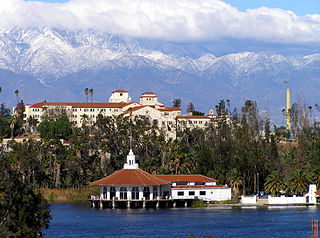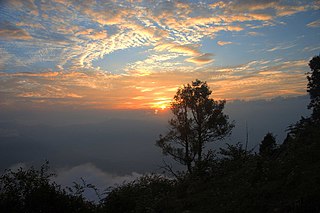
A biome is a community of plants and animals that have common characteristics for the environment they exist in. They can be found over a range of continents. Biomes are distinct biological communities that have formed in response to a shared physical climate. Biome is a broader term than habitat; any biome can comprise a variety of habitats.

An ecoregion or ecozone is an ecologically and geographically defined area that is smaller than a bioregion, which in turn is smaller than a biogeographic realm. Ecoregions cover relatively large areas of land or water, and contain characteristic, geographically distinct assemblages of natural communities and species. The biodiversity of flora, fauna and ecosystems that characterise an ecoregion tends to be distinct from that of other ecoregions. In theory, biodiversity or conservation ecoregions are relatively large areas of land or water where the probability of encountering different species and communities at any given point remains relatively constant, within an acceptable range of variation.

Biogeography is the study of the distribution of species and ecosystems in geographic space and through geological time. Organisms and biological communities often vary in a regular fashion along geographic gradients of latitude, elevation, isolation and habitat area. Phytogeography is the branch of biogeography that studies the distribution of plants. Zoogeography is the branch that studies distribution of animals. Mycogeography is the branch that studies distribution of fungi, such as mushrooms.

Norco is a city in Riverside County, California, in the United States. According to city ordinances, the architecture of Norco “shall reflect a desired Western theme,” including qualities “described as rural, informal, traditional, rustic, low-profile and equestrian oriented.

Sclerophyll is a type of vegetation that has hard leaves, short internodes and leaf orientation parallel or oblique to direct sunlight. The word comes from the Greek sklēros (hard) and phyllon (leaf).

A biogeographic realm or ecozone is the broadest biogeographic division of Earth's land surface, based on distributional patterns of terrestrial organisms. They are subdivided into ecoregions, which are classified based on their biomes or habitat types.
Ecological land classification is a cartographical delineation or regionalisation of distinct ecological areas, identified by their geology, topography, soils, vegetation, climate conditions, living species, habitats, water resources, and sometimes also anthropic factors. These factors control and influence biotic composition and ecological processes.

A savanna or savannah is a mixed woodland-grassland ecosystem characterised by the trees being sufficiently widely spaced so that the canopy does not close. The open canopy allows sufficient light to reach the ground to support an unbroken herbaceous layer consisting primarily of grasses.

Montane grasslands and shrublands is a biome defined by the World Wildlife Fund. The biome includes high altitude grasslands and shrublands around the world. The term "montane" in the name of the biome refers to "high altitude", rather than the ecological term which denotes the region below treeline.

Tropical climate is one of the five major climate groups in the Köppen climate classification. Tropical climates are characterized by monthly average temperatures of 18 ℃ (64.4 ℉) or higher year-round and feature hot temperatures. Annual precipitation is often abundant in tropical climates, and shows a seasonal rhythm to varying degrees. There are normally only two seasons in tropical climates, a wet season and a dry season. The annual temperature range in tropical climates is normally very small. Sunlight is intense.

An ecotone is a transition area between two biological communities, where two communities meet and integrate. It may be narrow or wide, and it may be local or regional. An ecotone may appear on the ground as a gradual blending of the two communities across a broad area, or it may manifest itself as a sharp boundary line.

Ice deserts are the regions of the Earth that fall under an ice cap climate. Despite rainfall totals low enough to normally classify as a desert, polar deserts are distinguished from true deserts by low annual temperatures and evapotranspiration. Most polar deserts are covered in ice sheets, ice fields, or ice caps.

Neora Valley National Park is situated in the Kalimpong district, West Bengal, India and was established in 1986. It spreads over an area of 88 km² and is one of the richest biological zones in the entire Eastern India. It is the land of the elegant red panda in the pristine undisturbed natural habitat with rugged inaccessible hilly terrain and rich diverse flora and fauna making this park an important wilderness zone.
Phytogeography or botanical geography is the branch of biogeography that is concerned with the geographic distribution of plant species and their influence on the earth's surface. Phytogeography is concerned with all aspects of plant distribution, from the controls on the distribution of individual species ranges to the factors that govern the composition of entire communities and floras. Geobotany, by contrast, focuses on the geographic space's influence on plants.

Santa Rosa National Park, is a national park, in Guanacaste Province, northwestern Costa Rica, it was created in 1966 by decree 3694.

Reig's opossum is a South American opossum species of the family Didelphidae, discovered in 2004. It is named after Argentine biologist Osvaldo Reig (1929–1992). It was initially found in montane forest in Canaima National Park, Venezuela at an elevation of 1300 m in the Sierra de Lema. It is typically found between 1100 m and 2050 m on Mount Ayanganna.

Nama Karoo is a xeric shrubland ecoregion located on the central plateau of South Africa and Namibia. It occupies most of the interior of the western half of South Africa and extends into the southern interior of Namibia.














